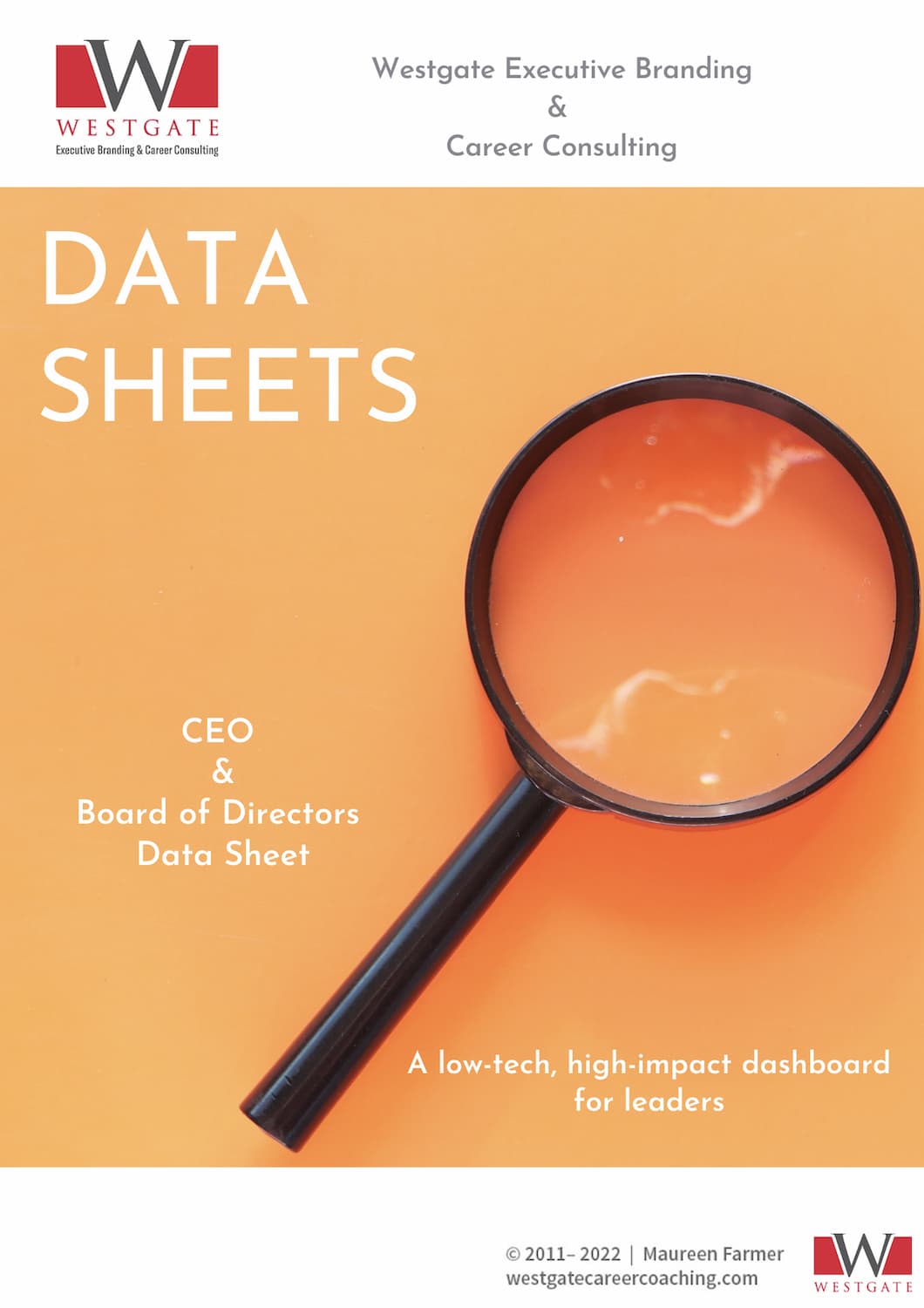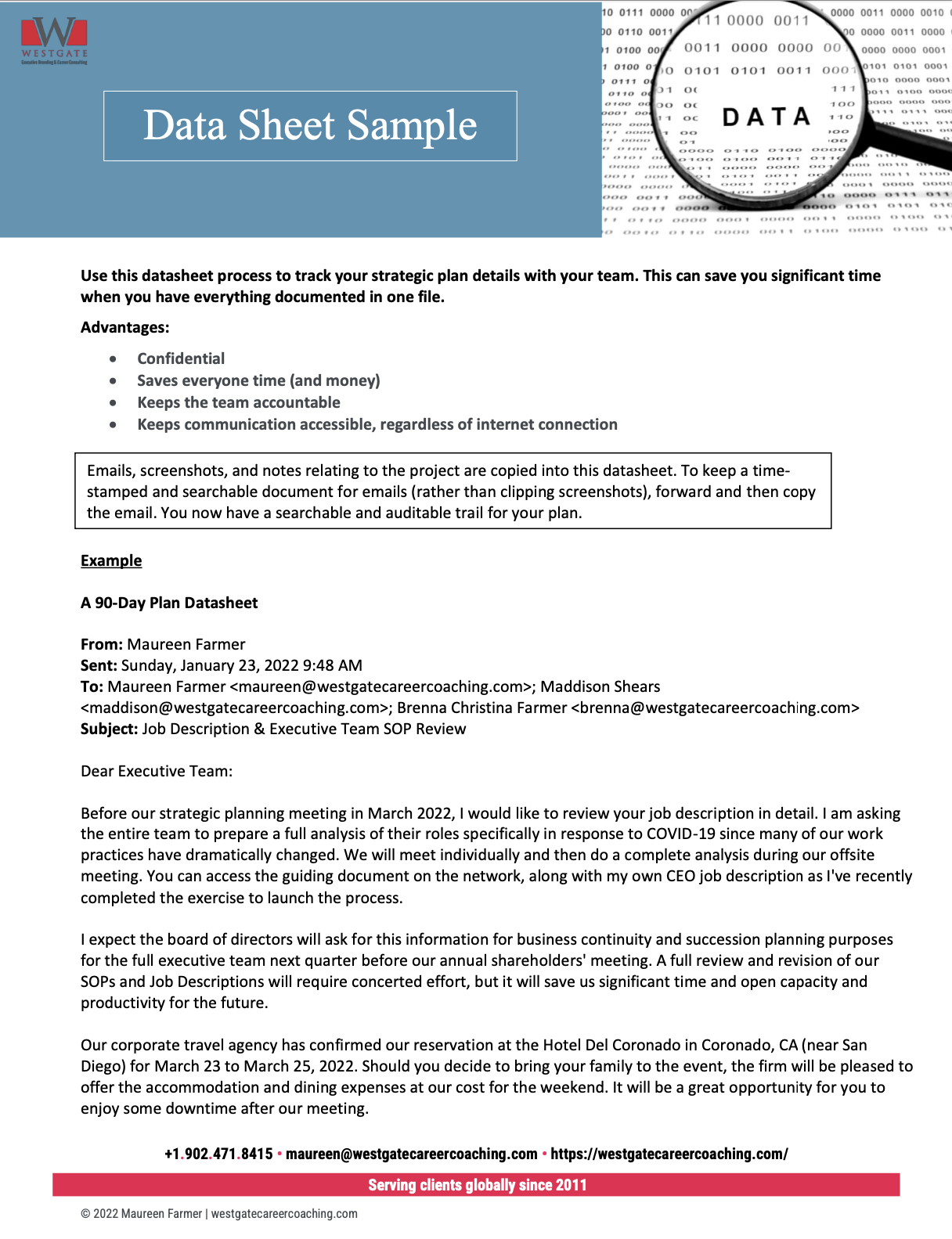Be a standout CEO with an easy-to-use data sheet
A data sheet is a low-tech, high-impact process for tracking information on a team, with the board of directors, and for projects requiring the input of many participants. The data sheet is not intended to replace an enterprise resource system, such as project management software.

What is a data sheet and how do you use it?
The data sheet is intended to help you stay organized and accountable over a discrete period of time, for example, 90-days. The biggest benefit of a data sheet is to help you put your hands on the right information at the right time. The tools required are (1) a Word document and (2) a snipping tool and (3) your email program.
A bonus tool for simplifying the process is audacity and/or the dictate tool in Word document so that you can both include an audio file in your data sheet and/or transcribe what you are saying in real-time.

Why do you use a data sheet?
Saving time and optimizing performance will have significant benefits to you as you launch a new project or onboard to a new organization as the CEO or other leader. Of course, anyone can use it, and everyone should. I have data sheets that are more than 15 years old, and they’ve become a historical record of the progression of a project or process over time.
On average, an employee spends roughly 30% of their workday searching for information (Source: International Data Corporation). If you extrapolate this statistic across your direct reports’ salary, imagine the significant costs you will avoid.

When do you use a data sheet?
Data Sheets should be used for a discrete project or when you need to keep a confidential and detailed account of written communications within a group of individuals. At Westgate, we use data sheets for every client, every project, and every campaign. It’s especially helpful with a large group or team, but it is also helpful as a stand-alone tool for a solitary process, such as when you need to keep track of important email communications.
Who should use a data sheet?
Anyone who is accountable to an investor, a board, or a CEO should use a data sheet to track the progress of various activities, such as an onboarding process or project. It may be especially helpful for an e-discovery process, although hopefully you never need to endure that type of razer-focused scrutiny of your business activities, communications, and transactions. However, it can save you mountains of time by keeping pesky details organized and make you look like a hero in front of your board when you’re able to put your hands on a detail you had long forgotten about.
According to International Data Corporation, an enterprise employing 1,000 people wastes nearly $2.5 million a year due to an inability to locate and retrieve information.

How do you use a data sheet?
The data sheet requires a disciplined approach and at Westgate, it’s simply become a standard practice for our team. We try to keep as many details out of email inboxes as possible ensuring that everyone has access to important information on a project. Yes, there are many ERP solutions in the marketplace for this purpose, but not everyone knows how to use them and not everyone wants to.
Even Fortune 500 corporate executives use the data sheet as a means of insurance against unwarranted or unfounded complaints. The higher level in an organization, the more is at stake for your reputation.
Essentially, use a Word document (or other word processing software) as a warehouse for emails received and sent to contain screenshots of images, websites, and other digital resources. Everything is in one spot for easy access and tracking.
You can also include audio clips of quick thoughts or relevant conversations between yourself and other team members. We use audacity for this (free software) and we also use the dictate tool in Word document for transcribing audio in real-time.
We have built a sample data sheet to illustrate the different ways it can be used.

A note from the team
Maddison Shears—Digital Marketing Manager

Data sheets are incredibly useful for communication and performance optimization when you are working in a virtual space. There is plenty of communication conducted each week via email, quick phone calls, and in shared documents. If we have a thread that is significant to a particular project or client, we add it to the data sheet. If I am having a brief meeting with a client or colleague, I add it into the relevant data sheet. If I am having a brief meeting with a client or colleague, I add it to the relevant data sheet. If we confirm a new process within our systemization, we add it it to the data sheet.
On any given day, I can search within the relevant data sheet for keywords, and I can quickly access the information. It’s also an excellent accountability tool. If I’m not certain what I said I would take charge on in regards to a project, it is likely documented in the data sheet.
It can also be a useful guide when building out SOPs. I will go into the data sheet for a project that we require an SOP on and a lot of information can be gathered from there, spanning a considerable amount of time.
It requires consistency and while it can feel time-consuming at first, it becomes part of your process, and it will save you plenty of time in the long run.
For example, if I am working with a client who could benefit from a previous process or conversation I had with a similar client from many months or even years ago, I can access that previous data sheet and find what I am looking for instantly. It is much more productive than spending copious amounts of time searching email threads.
We have shared this tool with some of our clients and they have incorporated it into their own processes.
As mentioned, there are other tools out there that can be used for similar purposes, but it likely comes at a cost and with necessary training. These data sheets require familiarity with Word documents.
Whether you are a board director, CEO, or team lead, consider sharing this low-tech, high-impact tool with your team at your next meeting.

